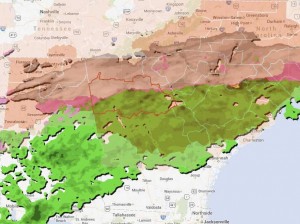Last week we published a post about Atlanta’s response to the 2-inch snowstorm that hit the area on January 28, 2014. Here we are two weeks later, staring in the face of a much bigger storm that the National Weather Service is predicting will be of “historic proportions“.
Governor Nathan Deal of Georgia has quite a bit of work cut out for him. He promised to research and begin rolling out changes based on the findings and advice of an expert panel assembled after the January snowstorm. How quickly such changes and recommendations could have been implemented is yet to be seen. But some lessons have clearly been learned already.

Exercising an abundance of caution, Gov. Deal has at this point declared a state of emergency for the majority of Georgia and has called up multiple reserve resources to deal with the effects of the storm. He’s closed schools, told state employees to stay home, and made multiple public announcements to stay off the roads. Local utilities and infrastructure support have also taken heed and are also actively engaged in shoring up resources and making sure that they are over-prepared for this potentially “catastrophic event“.
Interestingly enough, there are already news reports quoting people wondering whether too much caution is being exercised, and whether all of the warnings, extra preparation, and calling up of resources is really necessary.
It is fair to wonder how much of the current response is a result of fallout from the last storm. Governor Deal and other officials in Georgia clearly do not want a repeat of the issues from two weeks ago, from both a public safety perspective and a political one.
But it would be unfair to start criticizing the state for expenditures or extra precautions related to storm preparation if its impact ultimately turns out to be less dire than predicted – planning and preparing for a big storm is a complex process that involves multiple considerations: storm parameters, resources, vulnerability, and emergency management capabilities.
Storm parameters are estimates whose accuracy improves as the storm gets closer. Weather prediction has become much more accurate now but swings in predictions are still quite normal even a few hours before the storm hits.
Resources are a critical part of a response. Chicago’s O’Hare airport can continue near-normal operation at snowfalls of an inch per hour while Atlanta’s Hartsfield Airport is shut down in a few hours at this rate of snow fall. The gigantic snow removal equipment lined up at O’Hare is the difference.
Vulnerability captures the impact the same event can have on different populations and areas. An area with many old and tall trees that has not had a storm in a decade and has wires on poles is a lot more vulnerable than a city with underground wiring. Populations of elderly and children are also more vulnerable to effects of gridlock and blocked roads. Shutting down schools and prioritizing access to hospitals, nursing homes, and adult living communities is part of mitigating vulnerability.
Emergency Management. The final piece is management – the communication and control of the emergency response and the preparation. This deals with the ability of a region to coordinate its activities and optimize the response over a region. The ability to deploy resources effectively is critical. For example, in many disasters, crews brought in via mutual aid may be underutilized because the processes do not exist to effectively assign them to rapidly emerging tasks.
With all four considerations addressed, a state/region can have more confidence in its response and provide the best possible response to a storm – neither overreacting nor being complacent – with the ability to tune the response quickly when the storm deviates from predictions.
Unless there’s a systemic problem where money is lost on unneeded infrastructure and resources, the fact is that storms are, as the saying goes, as unpredictable as the weather. While it is prudent to err on the side of caution, there is a price to pay for caution as well – closing down the economy of a metropolitan region is a major impact as well. Finding the right balance is never an easy project.
photo credits: CNN, National Weather Service








